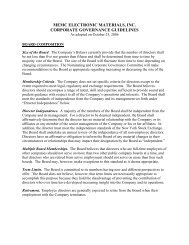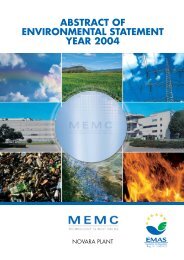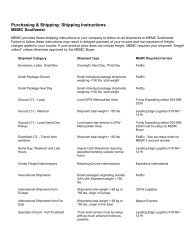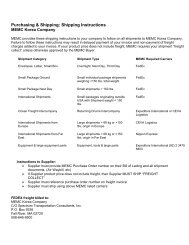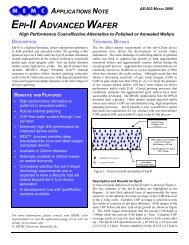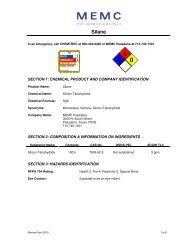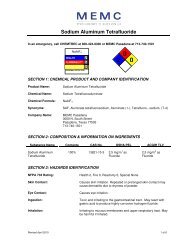BUILDING ON THE PAST, READY FOR THE FUTURE: - MEMC
BUILDING ON THE PAST, READY FOR THE FUTURE: - MEMC
BUILDING ON THE PAST, READY FOR THE FUTURE: - MEMC
Create successful ePaper yourself
Turn your PDF publications into a flip-book with our unique Google optimized e-Paper software.
<strong>MEMC</strong> worldwide R&D Cleanroom Lab, St. Peters.<br />
surface are eliminated, leaving a deep denuded<br />
zone for IC fabrication. Elimination of all crystalrelated<br />
harmful defects in the real estate used for<br />
IC device fabrication area is an optimal solution for<br />
today and future device generations.<br />
300MM waFers<br />
In 1991, the push began to develop 300mm wafers.<br />
<strong>MEMC</strong>’s customers, working constantly to maintain<br />
their own competitive edge, predicted they could<br />
achieve about 2.25 times more devices on each<br />
wafer with the transition from a 200mm wafer to a<br />
300mm wafer.<br />
While the move to 300mm wafers would entail<br />
capital expenditures by the device manufacturers<br />
for new equipment and facilities to handle the<br />
larger diameter, those costs would not increase in<br />
proportion to the surface area, largely because the<br />
300mm wafer meant less wasted silicon near the<br />
wafer edge where the rectangular devices meet the<br />
curved outer diameter of the wafer.<br />
<strong>MEMC</strong> began producing and selling 300mm<br />
wafers by the end of 1995. The shift from 200mm to<br />
300mm wafers again involved subtle evolutionary<br />
refinements of the basic manufacturing process.<br />
Tighter flatness specifications were achieved by<br />
the development of double-sided polishing, which<br />
helped to keep the device lines cleaner. This is<br />
because the backside of the wafer was polished<br />
smooth and no longer had the rough surface<br />
composed of pits from etching. The etch pits acted<br />
as particle traps and released the particles during<br />
wafer processing, causing some contamination of<br />
the device lines. In addition, <strong>MEMC</strong> added edge<br />
polishing to the process. This also helped to keep<br />
the device lines clean, especially with the advent of<br />
immersion lithography in the fabrications. Though<br />
edge grinding was introduced in the manufacture<br />
of smaller diameter wafers, edge polishing further<br />
increased the wafer’s chip resistance.<br />
<strong>MEMC</strong> was already supplying 300mm wafers to<br />
many of the twenty-six leading semiconductor<br />
device makers worldwide when the first phase of the<br />
300mm research and development line at St. Peters<br />
was completed in March of 1997. The line included a<br />
full set of innovative equipment to convert 300mmdiameter<br />
silicon crystals into 775-micron thick wafers<br />
with ultraflat, polished surfaces.<br />
In October of 1997, <strong>MEMC</strong> celebrated the opening<br />
of St. Peters’ state-of-the-art large-diameter wafer<br />
production facilities. According to then president<br />
and COO, Dr. Robert Sandfort, of the more than $600<br />
million in capital investments spent worldwide in<br />
1996, $150 million of it was spent at the St. Peters site.<br />
Sources:<br />
Electronic News, November 14, 1988<br />
St. Louis Business Journal, April 23, 1990<br />
A Global Company 63



